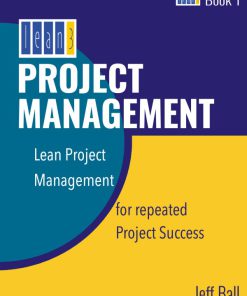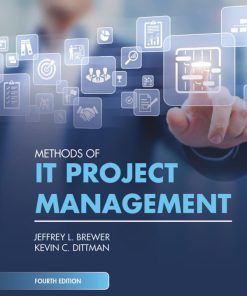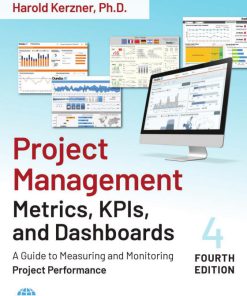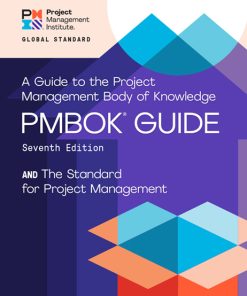(Ebook PDF) Project and Program Management A Competency-Based Approach 4th edition by Mitchell Springer 1557538581 978-1557538581 full chapters
$50.00 Original price was: $50.00.$25.00Current price is: $25.00.
Authors:Mitchell L. Springer; , Series:Management [1036] , Author sort:Springer;, Mitchell L. , Languages:Languages:eng , Published:Published:Oct 2018 , Publisher:Springer
Project and Program Management: A Competency-Based Approach 4th edition by Mitchell Springer – Ebook PDF Instant Download/DeliveryISBN: 1557538581, 978-1557538581
Full download Project and Program Management: A Competency-Based Approach 4th edition after payment.
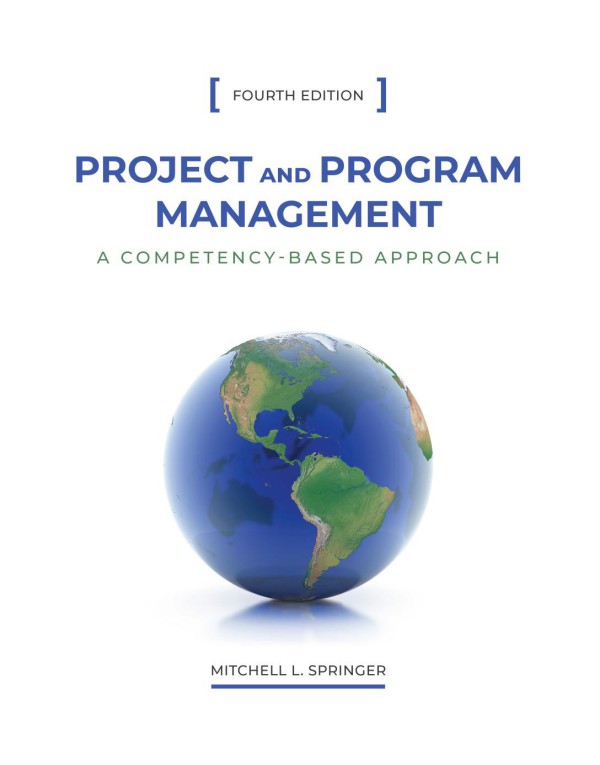
Product details:
ISBN-10 : 1557538581
ISBN-13 : 978-1557538581
Author: Mitchell Springer
This fourth edition has been significantly revised, with every chapter updated. The volume considers the magnitude of recent social, political, and technological changes, and the impact is represented throughout this book. Included are insights from numerous students who bring to the forefront their current real-world practices from their individual businesses, industries, and disciplines.
Project and Program Management: A Competency-Based Approach 4th Table of contents:
List of Illustrations xii
Preface xix
Introduction 1
Chapter 1. Program/Project Management Competencies 5
Student PM Competency Model Paper Guidelines 7
Chapter 2. The Importance of Program/Project Management 11
Chapter 3. Process Management—Evolution and Definition 19
Historical Orientation 19
General Program Planning Models 25
Integrated Linear Models versus Integrated Nonlinear Models 26
Evaluation Methodologies and Accountability 27
Composition of a Planning Process 28
Chapter 4. Contract Types—What Type of Contract Should I Enter Into? 31
Factors in Selecting a Contract Type 32
Fixed Price Contracts 33
Cost Reimbursement Contracts 35
Time and Materials Contracts 37
Labor Hour Contracts 37
Letter Contracts 38
Exercises 38
Chapter 5. The Bidding Process—Obtaining a Price Quote 41
Bid Organization 43
Responsibility Assignment Matrix 45
Before the Request for Proposal 45
On Receipt of the Request for Proposal 45
Proposal Generation Process 48
Review and Approval Process 48
Submittal Process 50
Post-Submittal Process 50
Post-Decision Process 51
Statement of Work 52
Technical Specification 53
Work Breakdown Structure 54
Classes of Estimates 54
Chapter 6. Defining the Work to be Performed 57
A Shortened Perspective 57
A More Detailed Perspective 65
Chapter 7. Scheduling and Staffing the Work 77
Types of Schedules 77
Network Approaches 82
Closing Thoughts on Developing a Network Diagram 87
Master Schedule 88
Intermediate Schedule 88
Detailed Schedules 89
Human Resource Plan 90
A More Detailed Perspective 91
Chapter 8. Risk Management—Mitigating the Impact 103
Risk Planning 104
Risk Assessment 105
Risk Analysis 107
Risk Handling 110
Chapter 9. Disruptive Technologies—Thinking Outside of the Box 113
Chapter 10. Cost, Schedule, and Performance Management—
A Quantitative Premise 121
Defining the Initial Budget 121
Determining How We Are Performing against the Initial Budget 122
Keeping Track of Actual Costs 123
Getting Back on Schedule and Within Cost 124
A More Detailed Perspective 125
Course Project Details and Examples 141
Chapter 11. Multiple Generations in the Workplace—
It’s How We Grew Up 147
Late Adulthood Gerontological Life Phase (60+) 151
Middle Adulthood Gerontological Life Phase (40–60) 153
Early Adulthood Gerontological Life Phase (20–40) 154
Adolescence Gerontological Life Phase (10–20) 155
Cohort Group (Veterans) 155
Cohort Group (Boomers) 160
Cohort Group (Generation X’ers) 166
Cohort Group (Gen Y; Nexters; Millennials) 171
The New Next Professional Working Adult Learner (2019 Perspective) 176
Who Are the Students? 177
Why Are College Costs So High? 179
Moving Back Home and Its Implications 181
Postponing Marriage and Children 182
Postponing the Purchasing of Material Possessions 186
Concluding Thoughts 187
Cohort Group (Gen Z; iGen) 187
Concluding Remarks on the Nurture Side 194
Chapter 12. Connecting Generational Cohorts to Associative Thinking 195
Understanding the Breadth and Depth of a Discipline 195
“Seeing” across Disciplines 195
Practical Experience and Ability to Recognize the Bigger Picture 196
Ability to Recognize Cultural Realities 196
Understanding of Current Technologies 196
Unbounded by Hierarchical Pressures 197
Propensity for “Just Trying It” 197
Chapter 13. Leadership and Gender—A Science-Based Understanding 199
Differences in Neural Blood Flow Patterns 201
Differences in Structures of the Brain 202
Differences in Brain Chemistry 203
Leadership—Interpersonal Relationships 203
Leadership—Management Styles 204
Leadership—Things We Might See 204
Leadership—In Meetings 204
Chapter 14. Motivation and Leadership—Why We Do What We Do 207
Need Theories 207
Goal-Setting Theory 209
Reinforcement Theory 210
Equity Theory 210
Expectancy Theory 210
Chapter 15. Organization Design Models—
Not Right or Wrong, More or Less Applicable 213
Traditional 213
Product 215
Matrix 216
Project Management 218
Criteria for Selecting an Organizational Structure 219
Summary Remarks 219
Chapter 16. Building Teams—
Understanding Ourselves and Others through MBTI 221
Sensing (S) and Intuition (N) 221
Thinking (T) and Feeling (F) 222
Extraversion (E) and Introversion (I) 222
Judging (J) and Perceiving (P) 223
Type Combinations 223
Type and Organizational Change 223
Type Dynamics 224
Summary Thoughts by Type 225
Chapter 17. Capitalizing on the Collective Knowledge of the World 229
Availability of Skilled Labor 229
Skilled Labor Shortage Forecasts 230
Aging World Population 231
Retirement and the Working Senior Population 236
Science and Engineering Demographics 243
International Impact 247
Growing World Population 252
World’s Education 253
Outsourcing of Goods and Services 263
Concluding Thoughts on the International Impact 269
Innovation, Technology, and the Systems Integrator 269
Understanding Technology as a Discipline 271
Integrating Intersectional Ideas 278
Creating an Integrative Mind-set 279
Systems Engineering—
The Cross-Discipline Eclectic Nature of Knowledge 280
Diversify Our Knowledge through Multiple Job Experiences 281
Summary Thoughts 282
Technology from a Worldwide Perspective 282
The Bio-Economy—A Truly Worldwide Experience 284
Dwindling Graduate Student Enrollments
in Distance-Based Programs (An Example) 290
Chapter 18. Establishing Program/Project Management as a Discipline 305
Chapter 19. Managers, Leaders, and Entrepreneurs 315
Defining Management 315
Management Functions 316
Management Roles 316
Management Skills 318
Leaders 319
Theories of Leadership 319
Power 322
Military Leadership Fundamentals 323
Entrepreneurs 325
Ethics at All Levels 327
Concluding Thoughts 328
Chapter 20. The American Social Economic Context 329
Prior to 1920 331
1920 to 1945 338
1945 to 1960 340
1960 to 1980 344
1980 to Present 346
Chapter 21. Career Development—Models 349
Moving Forward—The Four Questions 353
Educational Requirements of Engineering and Technology
Professional Working Adult Learners (Real-Life Example) 365
Mapping Employee Training and Development to Market
Requirements: Using a Corporate Market-Based Approach 372
Chapter 22. Succession Planning—Providing Opportunities for Growth 375
Why Is Succession Planning Important? 375
Who Is Succession Planning For? 376
Activities of Effective Succession Planning 376
What Do We Do When a Position Vacates? 376
Things to Remember 378
Who Is Responsible? 378
Chapter 23. The Business Case for Diversity and Inclusivity 379
Business Case for Diversity and Inclusivity: It’s All about Growth 382
Millennials Usher in Minority Majority 385
The Millennial View of Diversity and Inclusivity 387
Coercion, Groupthink, Bias, and Inherent Discrimination 390
The Need to Survive and Reproduce 390
Reexamining Our Subconscious and Unconscious Mind 394
We Are More Alike Than Different—Genomically Speaking 395
Chapter 24. Effective Communication Skills 397
Encoding and Decoding Skills 398
Basic Rules for Addressing an Audience 399
Questions After the Presentation 400
Nonverbal Communication Skills 400
Listening Skills 400
Reading Skills 401
Skipping Judiciously 401
Communication Barriers 402
Organizational Communication 402
Conducting an Effective Meeting 403
Chapter 25. Change Management—People, the Hardest Part 405
Organizational Development—The Context of Change 405
Models of Change Management 407
Activities or Phases of the Change Management Process 409
Why Change Fails 410
Trust Through Character, Communication, and Capability 411
Managing Our Own Personal Change 412
Running the Academy as a Business (An Example) 415
The Synergistic Implications of Personal Ownership
(A Comprehensive Example) 424
Creating Pride in Individual Efforts 425
How to Create Vision through Market-Based Analysis 427
Ownership Can Create Motivation 428
Fear Can Equally Stifle Action 430
Motivation is Hampered Through Entitlement 432
Closing Thoughts 434
Appendix A—Evaluating the Program Plan 435
Committee of Stakeholders 435
Primary Activities 435
Interviewing Program Participants 436
Outcome-Based Evaluation Methodology 437
Summary of Outcome-Based Evaluation Data Analysis Method 439
Appendix B—Executing the Program Plan 441
Appendix C—Changes to the Program Plan 447
Recognizing Changes 451
What Is a Change? 452
What Determines How a Contract Is Changed? 453
How Do Contractual Relationships Affect Changes? 453
Why Are Government Contract Changes Unique? 453
Why Do Changes Occur? 454
When Are Changes Likely to Occur? 456
What Are the Elements of a Change? 457
Common Names Given to Changes 457
What Types of Change Orders Can Occur? 460
Who Has the Authority to Order Changes? 461
When Can Changes Be Ordered? 463
What Changes Can Be Ordered? 463
What Response Does a Change Order Require? 464
When Is Changed Work Performed? 464
Appendix D—Program Planning Master Process Flow 467
Establish Planning Organization 467
Establish Program Management Library 469
Generate Requirements Database 472
Generate Master Program Schedule 473
Generate Preliminary Extended CWBS and Dictionary 475
Generate Preliminary Responsibility Assignment Matrix 477
Generate Intermediate Schedules 479
Generate Preliminary Detailed Schedules 480
Generate Human Resource Plan 482
Establish Program Organization 484
Post-Contract Award 485
Glossary 489
Bibliography 521
Index
People also search for Project and Program Management: A Competency-Based Approach 4th:
project and program management: a competency-based approach
project and program management a competency based approach 5th edition
project and program management a competency based approach
project and program management a competency based approach fifth edition
differences between project and program management




